Cloth in and out device
1. Open-width fabric feeding device
The fabrics in the workshop stacker are basically in a tension-free, folded and stacked state. If the fabric is directly put into the machine for finishing, it will easily produce wrinkles and skew, which will definitely affect the smooth progress of dyeing and finishing and the quality of the printed and dyed products. In order to overcome the above phenomenon, the fabric must be processed by the fabric feeding device before entering the machine for finishing. The purpose is:
(1) Give appropriate tension to the fabric so that the fabric can enter the machine flatly without causing wrinkles .
(2) Guide the fabric to run in the normal position agreed by the machine to prevent the fabric from excessive deviation from left to right.
(3) Make the dust and debris caught in the fabric fall down easily and naturally, or make it easy for the operator to detect and remove it in time, so as to prevent dust and other debris from entering the machine and damaging the rollers or affecting product quality. In addition, if you find that the cloth is knotted or not sewn, you can stop the machine in time to act as a buffer.
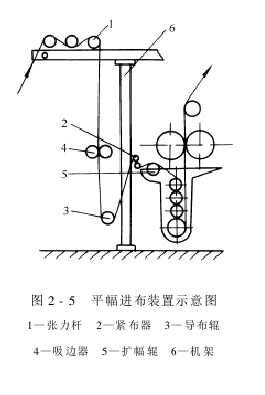
Flat width The fabric feeding device is commonly known as the fabric feeding frame, as shown in Figure 2-5. It is mainly composed of a tension rod (also called a fabric guide tube), a fabric tensioner, an expansion roller, an edge suction device, a fabric guide roller, a frame, etc. The tension rod gives appropriate warp tension to the fabric; the fabric tensioner can not only increase the warp tension of the fabric, but also adjust its warp tension appropriately according to different fabric varieties; the function of the expansion roller is to expand the fabric to prevent wrinkles And wrinkle removal; the function of the edge suction device is to provide weft tension to the fabric to prevent the fabric from curling, and automatically guide the fabric to run in the middle of the machine to prevent the fabric from excessive left and right deviation.
The edge suction device and widening roller in the open-width fabric feeding device will be discussed in detail in the third and fourth sections of this chapter. Here we focus on the structure of the tension rod and fabric tensioner.
1. Tension rod
Generally consists of a set of cloth guide rods (wooden poles or galvanized pipes) fixed on the frame and parallel to each other. Similar to the fixed guide roller, its function is to guide the movement of the fabric and use the friction between its surface and the fabric to increase the warp tension of the fabric.
In order to adapt to the different requirements of different fabrics for the warp tension of the fabric, when changing the fabric type, you can wear more or less cloth guide rods appropriately to adjust the warp tension of the fabric within a certain range. During use, you should always check whether the club face is clean to avoid scratching the fabric, and check whether each pole is level and loose.
2. Fabric tensioner
As shown in Figure 2-6(a), the fabric tensioner is a combined adjustable fixed fabric guide roller, which consists of a bracket, an adjustment mechanism and a fabric tensioning rod.
(1) Bracket: It is a bracket that supports the cloth tensioner. It is composed of a mandrel, a support plate (iron plate or cast iron), a bearing seat and other parts.
(2) Adjustment mechanism: It consists of a set of worm gears and worms. The worm gear is fixed on the support mandrel, and the worm is connected to the handwheel. When the operator turns the handwheel, the worm gear is driven by the worm, causing the support connected to the worm gear to rotate. In this way, the relative positions of the two fabric tightening rods fixed on the bracket also change, that is, the wrapping angle of the fabric on the fabric tightening rod is changed to achieve the purpose of adjusting the fabric tension.
In addition, ratchets, pawls or movable pins are also used as adjustment mechanisms.
(3) Tight cloth rod: as shown in Figure 2-6(b). If the position of the tightening rod is adjusted from I-I′ to II-II′, the wrapping angle of the fabric on the tightening rod will also change from α1 to α2 , obviously α2 >α1, the warp tension of the fabric increases. Therefore, the fabric tensioner can adjust the warp tension of the open-width fabric within a certain range.
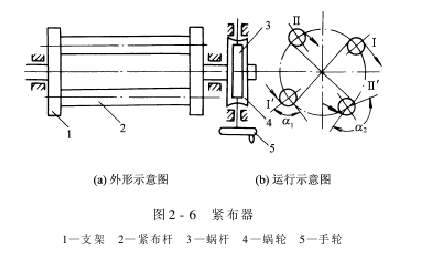
Tight cloth The rod is usually made of galvanized pipe (or brass pipe, stainless steel pipe) with a diameter of 50mm. The surface of the tight-fitting rod must be clean and resistant to acid and alkali corrosion. The fabric and the tight fabric rod slide against each other.
2. Open-width fabric dispensing device
Open-width fabric dispensing is mostly done with left and right fabric discharging. The open-width cloth output device is commonly known as the cloth drop frame. Its function is to lead the fabric out of the working machine and swing it at a certain amplitude so that the fabric can be piled neatly into the stacking car.
The open-width cloth discharging device is mainly composed of a traction cloth guide part, a swing cloth drop part, a transmission system, a frame, etc., as shown in Figure 2-7.
1. Pulling and guiding part
The function of this part is to pull and guide the open-width fabric in the previous machine. It consists of an active cloth discharging roller, a cloth pressing roller and a pressure adding and releasing device.
(1) Active cloth discharging roller: The roller body of the active cloth discharging roller is generally made of wood, but it is also made of iron pipes. The roller diameter is generally between 200 and 250mm. Both ends of the roller are fixed with bearings. on the rack. The shaft end of the roller is driven by a pulley or sprocket, and its linear speed is generally about 3% to 5% faster than the fabric. In some cases, it is 15% to 20% faster. The roller surface should be wrapped flatly with a rubber belt or felt belt to increase the friction between it and the fabric to avoid slipping when exporting the fabric.
(2) Pressing roller: The roller body of the pressing roller is made of steel pipe, with chrome plating on the surface. It is also made of wood or copper pipe, with a diameter of 120~125mm. The cloth pressing roller is installed on the active cloth discharging roller and rotates due to friction on the surface of the active cloth discharging roller.
(3) Pressure relief device: mainly composed of handle, connecting rod and lever. Push the handle up and down to pressurize or relieve pressure to adapt to the different pressure requirements of different fabrics when dropping.
Whether the cloth needs to be pressurized should be determined by the thickness of the fabric, dryness and wetness, running speed, machine characteristics and the condition of the swinging cloth drop part.
① Under normal operating cloth speed, wet fabric does not need to be pressurized, while dry fabric or fabric should be pressurized when running at high speed.
② When the fabric is pulled by the active cloth discharging roller or the cloth discharging device is far away from the active cloth guide roller behind the previous machine, the cloth pressing roller should be pressurized.
③Some jacquard and knitted fabrics should not be pressurized.
④ When the two drop rollers in the cloth discharging device are in upper and lower contact, there is no need to pressurize the cloth pressing roller.
2. Swinging cloth dropping part
As shown in Figure 2-8, the function of the swinging cloth dropping part is to swing the fabric from the traction roller at an appropriate frequency, and to lay it flatly on the pile of cloth In the car or on a pile of cloth. It consists of two parts: a swing mechanism and a cloth dropping device.

(1 )Swing mechanism: It consists of a driving pulley, a connecting rod, a rocker arm (swinging hand), etc., and is made based on the working principle of the crank rocker mechanism.
The crank-rocker mechanism is shown in Figure 2-9. It is composed of four components connected to each other by hinges. Among them, the AD component is fixed and is called a rack. The AB component is connected to the frame and can rotate in a circle, which is called a crank. The CD component is also connected to the frame, but it can only swing at a certain angle φ, which is called a rocker. When the crank AB makes a circular motion, the rocker CD swings back and forth at a certain angle φ. When crank AB and connecting rod BC are in line, the rocker is at the extreme position of its swing. In the figure, C1 is the right extreme position, and C2 is the left extreme position. It must be pointed out here that it must work when AB is smaller than CD.
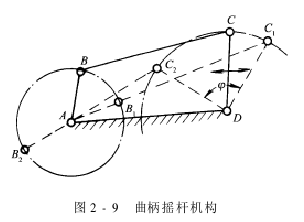
Crank by The traction roller drive rotates at a constant angular speed, and drives the rocker equipped with the drop roller to swing back and forth through the connecting rod, so that the fabric swings and falls at a certain amplitude. There are long grooves on the driving pulley and the rocker arm. If the position of the connecting rod end pin in the long groove is changed, the swing amplitude of the rocker arm can be adjusted. The swing amplitude is generally between 400 and 1000mm, and the number of reciprocations is between 30 and 60 times/min.
(2) Cloth drop roller: There are two cloth drop rollers, which are installed at the end of the rocker arm and driven through a pulley or sprocket. Its linear speed should be about 6% to 10% faster than the cloth speed. The height of the cloth drop roller from the ground should be greater than 1.9m to ensure the safety of the operator.
There are three arrangements of drop rollers, each with its own characteristics, as shown in Figure 2-10.
①Up and down contact type: two doffing rollers are arranged vertically, as shown in Figure 2-10(a). The drop cloth roller is a driving roller, and the upper drop cloth roller is vertically pressed on the drop cloth roller due to its own weight, and rotates due to contact friction with the surface of the drop cloth drop roller. This type of drop roller is inconvenient during cloth threading operation and is prone to damage on dark-colored dry fabrics. It is also not suitable for embossed fabrics and light fabrics.
②Horizontally separated type: The two doffing rollers are arranged horizontally and separately, as shown in Figure 2-10(b). The shafts at the same end of the two doffing rollers are meshed and driven by a pair of spur gears. This form is improved over the vertical contact type and is suitable for heavy fabrics, embossed fabrics and wet fabrics. However, when running at high speed, slack and floating phenomena are likely to occur between the active cloth delivery roller and the doffing roller, and the fabric is easily involved in the doffing roller. Especially for light and thin fabrics, the loose and floating phenomenon is more serious, so an additional stopper should be used. Wind panels and other corresponding measures.
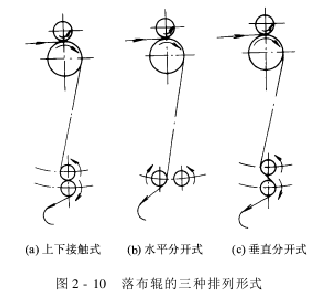
③Vertical Separate type: The upper and lower cloth doffing rollers are arranged vertically and separately, as shown in Figure 2-10(c). The two doffing rollers are driven by a belt. During the swing doffing process, the fabric can always be in contact with the upper and lower doffing rollers, so it is applicable to high and low speeds, thick and thin fabrics and embossed fabrics. This device is currently commonly used in domestic printing and dyeing machinery.
In some cases, there is also an open-width cloth discharge device with a cloth dropper instead of a cloth dropper roller, as shown in Figure 2-11. This kind of drop bucket type open-width cloth discharging device is suitable for high-grade light and thin fabrics with high count yarns, and can avoid cloth surface scratches and loose and floating phenomena.
3. Drop cloth rolling device
Drop cloth rolling device is a device that winds the open-width fabric led out from the traction guide part into a cloth roll. With the increase in the speed of dyeing and finishing equipment, more and more fabrics are being rolled into rolls. This is because on the one hand, the cloth can be rolled into a roll to overcome various defects of high-speed swinging cloth, and the cloth is flat, which is very suitable for some fabrics that are prone to wrinkles, such as chemical fibers, polyester-cotton blended chemical fiber fabrics, etc.; on the other hand, It can be rolled, has a large capacity for cloth, has a simple structure, is highly efficient, and can reduce the labor intensity of cloth discharging and transportation.
The large-scale cloth dropping and rolling device consists of an umbrella-handled cloth box, a cloth rolling device, a dropping shaft car and a transmission mechanism, as shown in Figure 2-12.
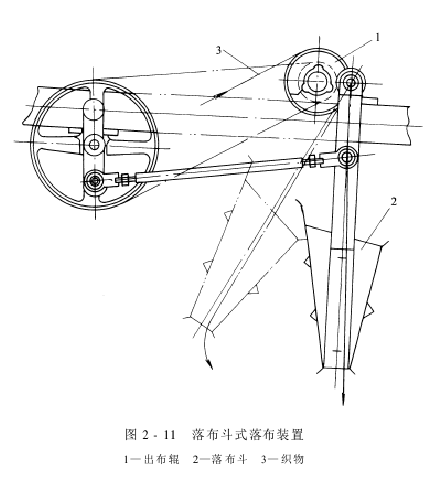
1. Umbrella handle type fabric storage box
Umbrella handle type fabric storage box is made of angle steel, and the inside is made of hard PVC board and pipe. The fabric capacity is 600~800m, and the fabric storage time can be up to 4~ 5 minutes, ensuring enough time to change the axis (the actual axis change only takes 2 minutes). After changing the shaft, the speed can be increased to finish the remaining fabrics in the box, which will increase the warp tension of the fabric and prevent wrinkles. Before changing the axis, slow down appropriately to store the cloth.
2. Cloth rolling device
There are many types of cloth rolling devices, but in terms of rolling methods, there are only two types: active cloth rolling device and surface drive cloth rolling device. The surface drive cloth rolling device places the cloth rolling roller on two (or one) driving rubber rollers rotating at a constant speed, and drives the cloth rolling roller by surface friction of the driving rubber rollers. The active winding device uses a variable speed motor to directly drive the winding roller. That is, as the winding diameter increases, the speed of the winding roller slows down accordingly to keep the winding line speed unchanged.
The surface drive cloth rolling device consists of a cloth rolling automatic rubber roller, a lifting rocker arm frame, etc. The active rubber roller on it is pressed tightly behind the cloth rolling roller of the drop-off car, and relies on friction to drive the cloth rolling roller to rotate and roll the cloth. As the diameter of the roll cloth increases, the rocker arm frame and the driving rubber roller also rise. After the roll is filled with the shaft, the machine immediately stops, opens the air valve, and lifts the rocker arm and the driving rubber roller away from the cloth roll.
The surface levelness of the cloth rolling roller, rubber cloth pressing roller (HSA92~98), and cloth guide roller is 5/10000 to ensure the quality of the cloth rolling.
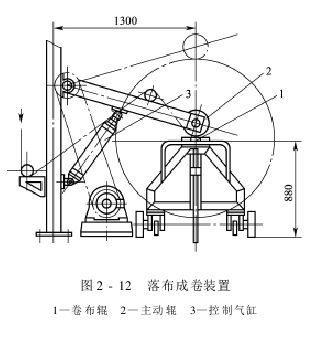
3. Drop cart
Drop cart, also known as cloth rolling cart, is a device used to carry cloth rolls. After the roll is filled with the shaft, it can be lifted and transported by battery truck.
4. Transmission mechanism
During the rolling process, the motor drives the active rubber roller to run at high speed. Through friction, the fabric is advanced and rolled.
AAASDFWETGD
Extendedreading:https://www.yingjietex.com/product/DE-24-Memory-Fabric.html
Extendedreading:
Extendedreading:
Extendedreading:
Extendedreading:
Extendedreading:
Extendedreading:
Extendedreading:
Extendedreading:
Extendedread





